

DRI. Experimental. Hopantenic acid. Pantogam was introduced in 1979.
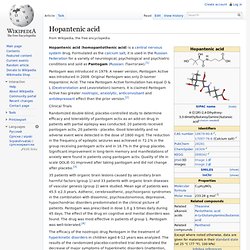
A newer version, Pantogam Active was introduced in 2008. Original Pantogam was only D-isomer Hopantenic Acid. The new Pantogam Active formulation has equal D & L (Dextrorotation and Levorotation) isomers. It is claimed Pantogam Active has greater nootropic, anxiolytic, anticonvulsant and antidepressant effect than the prior version.[2] Clinical Trials Randomized double-blind, placebo-controlled study to determine efficacy and tolerability of pantogam activ as an add-on drug in patients with partial epilepsy was conducted. 20 patients received pantogam activ, 20 patients - placebo. 35 patients with organic brain lesions caused by secondary brain harmful factors (group 1) and 33 patients with organic brain diseases of vascular genesis (group 2) were studied.
The efficacy of the nootropic drug Pantogam in the treatment of hyperkinetic disorders in children aged 6-12 years was analyzed. The Manufacturers Instructions For Use advise the following: [6] 4-Methylaminorex. 4-Methylaminorex (4-MAR, 4-MAX) is a stimulant drug of the 2-amino-5-aryloxazoline class that was first synthesized in 1960 by McNeil Laboratories.[1] It is also known by its street names "U4Euh" ("Euphoria") and "Ice".

It is banned in many countries as a stimulant. 4-Methylaminorex has effects comparable to methamphetamine but with a longer duration. The results of animal experiments conducted with this drug suggest that it has an abuse liability similar to cocaine and amphetamine. Pirisudanol. TB-21007. Cholinergic/Nicotinergic. The N,N,N-trimethylethanolammonium cation, with an undefined counteranion, X− In general, the word choline refers to the various quaternary ammonium salts containing the N,N,N-trimethylethanolammonium cation.
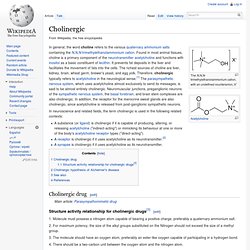
Found in most animal tissues, choline is a primary component of the neurotransmitter acetylcholine and functions with inositol as a basic constituent of lecithin. It prevents fat deposits in the liver and facilitates the movement of fats into the cells. Meclofenoxate. Meclofenoxate (Lucidril), also known as centrophenoxine, is a drug used to treat the symptoms of senile dementia and Alzheimer's disease.
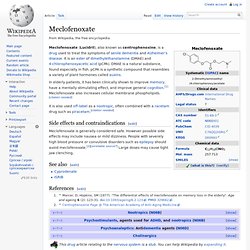
It is an ester of dimethylethanolamine (DMAE) and 4-chlorophenoxyacetic acid (pCPA). DMAE is a natural substance, found especially in fish. pCPA is a synthetic compound that resembles a variety of plant hormones called auxins. Indeloxazine. Indeloxazine (Elen, Noin) is a so-called cerebral activator which has been used in Japan for the treatment of cerebrovascular disease since 1988.[1][2] It acts as a serotonin releasing agent,[3] norepinephrine reuptake inhibitor,[3] and NMDA receptor antagonist,[4] and enhances acetylcholine release through indirect activation of the 5-HT4 receptor.[5][6][7] It has nootropic,[6][7][8][9] neuroprotective,[10][11][12][13] anticonvulsant,[14] and antidepressant effects.[3][15][16] See also[edit] References[edit] Jump up ^ Index nominum, international drug ... - Google Books. 2000.
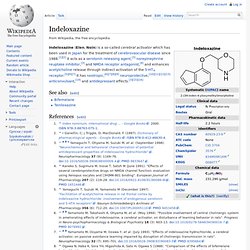
Ispronicline. Ispronicline (TC-1734, AZD-3480) is a drug which acts as a partial agonist at neural nicotinic acetylcholine receptors.
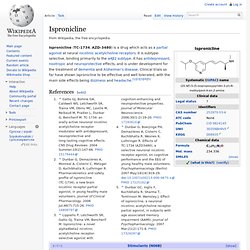
It is subtype-selective, binding primarily to the α4β2 subtype. It has antidepressant, nootropic and neuroprotective effects, and is under development for the treatment of dementia and Alzheimer's disease. Clinical trials so far have shown ispronicline to be effective and well tolerated, with the main side effects being dizziness and headache.[1][2][3][4][5] Jump up ^ Gatto GJ, Bohme GA, Caldwell WS, Letchworth SR, Traina VM, Obinu MC, Laville M, Reibaud M, Pradier L, Dunbar G, Bencherif M. Dopamine agonist. A dopamine agonist is a compound that activates dopamine receptors in the absence of dopamine.
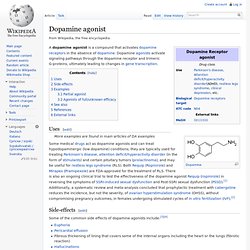
Dopamine agonists activate signaling pathways through the dopamine receptor and trimeric G-proteins, ultimately leading to changes in gene transcription. Uses[edit] More examples are found in main articles of DA examples Some medical drugs act as dopamine agonists and can treat hypodopaminergic (low dopamine) conditions; they are typically used for treating Parkinson's disease, attention deficit/hyperactivity disorder (in the form of stimulants) and certain pituitary tumors (prolactinoma), and may be useful for restless legs syndrome (RLS). Pemoline. Pemoline is a stimulant drug of the oxazoline class.
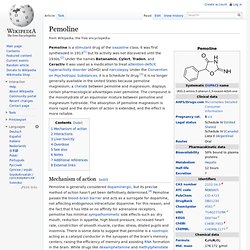
It was first synthesized in 1913[1] but its activity was not discovered until the 1930s.[2] Under the names Betanamin, Cylert, Tradon, and Ceractiv it was used as a medication to treat attention-deficit hyperactivity disorder (ADHD) and narcolepsy. Under the Convention on Psychotropic Substances, it is a Schedule IV drug.[3] It is no longer generally available in the United States because pemoline magnesium, a chelate between pemoline and magnesium, displays certain pharmacological advantages over pemoline.
The compound is the monohydrate of an equimolar mixture between pemoline and magnesium hydroxide. The absorption of pemoline magnesium is more rapid and the duration of action is extended, and the effect is more reliable. H3 receptor antagonist. An H3-receptor antagonist is a classification of drugs used to block the action of histamine at the H3 receptor.
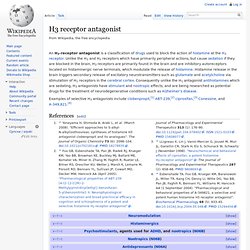
Unlike the H1 and H2 receptors which have primarily peripheral actions, but cause sedation if they are blocked in the brain, H3 receptors are primarily found in the brain and are inhibitory autoreceptors located on histaminergic nerve terminals, which modulate the release of histamine. Histamine release in the brain triggers secondary release of excitatory neurotransmitters such as glutamate and acetylcholine via stimulation of H1 receptors in the cerebral cortex.
Consequently unlike the H1 antagonist antihistamines which are sedating, H3 antagonists have stimulant and nootropic effects, and are being researched as potential drugs for the treatment of neurodegenerative conditions such as Alzheimer's disease. Dopamine reuptake inhibitor. A dopamine reuptake inhibitor (DRI) is a type of drug that acts as a reuptake inhibitor for the neurotransmitter dopamine by blocking the action of the dopamine transporter (DAT).
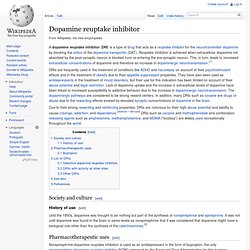
Reuptake inhibition is achieved when extracellular dopamine not absorbed by the post-synaptic neuron is blocked from re-entering the pre-synaptic neuron. This, in turn, leads to increased extracellular concentrations of dopamine and therefore an increase in dopaminergic neurotransmission.[1] DRIs are frequently used in the treatment of conditions like ADHD and narcolepsy on account of their psychostimulant effects and in the treatment of obesity due to their appetite suppressant properties. They have also been used as antidepressants in the treatment of mood disorders, but their use for this indication has been limited on account of their abuse potential and legal restriction. Mesocarb. Amfonelic acid. Amfonelic acid (AFA; WIN 25,978) is a research chemical with highly selective dopaminergic stimulant and antibiotic properties.[1]
Norepinephrine-dopamine reuptake inhibitor. A norepinephrine-dopamine reuptake inhibitor (NDRI) is a drug that acts as a reuptake inhibitor for the neurotransmitters norepinephrine and dopamine by blocking the action of the norepinephrine transporter (NET) and the dopamine transporter (DAT), respectively.[1] This in turn leads to increased extracellular concentrations of both norepinephrine and dopamine and, therefore, an increase in adrenergic and dopaminergic neurotransmission.[1] Uses[edit] Norepinephrine-dopamine reuptake inhibitors are used for Clinical depression, ADD, ADHD, Narcolepsy, and as antiparkinson agents.
List of NDRIs[edit] Many NDRIs exist, including the following: Note: Only NDRIs selective for the NET and DAT over the serotonin transporter (SERT) are listed here. Methylphenidate. Methylphenidate (trade names Concerta, Methylin, Ritalin, Equasym XL) is a psychostimulant drug and substituted phenethylamine approved for treatment of attention-deficit hyperactivity disorder (ADHD), postural orthostatic tachycardia syndrome and narcolepsy. The original patent was owned by CIBA, now Novartis Corporation. It was first licensed by the U.S.